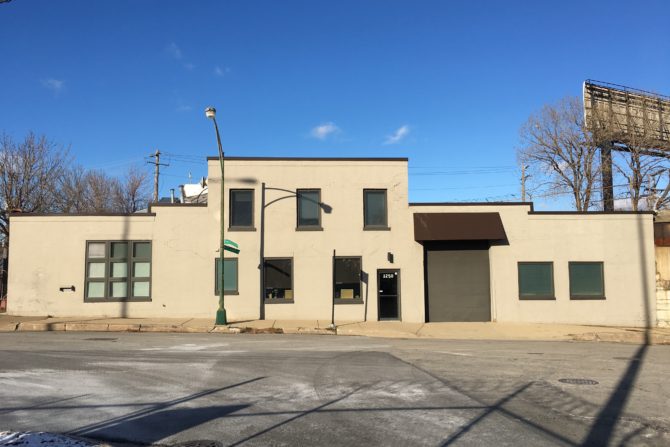Wedged between train tracks and a city maintenance yard, a new artistic space is taking shape. Tucked just east of the Kennedy Expressway at 1250 W. Augusta Boulevard is a two-story, triangle shaped building with unassuming tan brick. This will serve as the location of a new gallery, performance venue and a gathering place for the community.
The project, SITE/less, comes from Zephyr Dance’s artistic director Michelle Kranicke and architect Dave Sundry. The main focus of the 2,600-square-foot space, which opens in April 2018, is to unite different art forms and explore their boundaries.
The husband and wife team will take over the southeast corner of the former warehouse and host an art exhibition with Zephyr Dance that explores architecture as it relates to performance and visual art.
“Architecture is usually not represented in most of the arts forms, because it’s the envelope that all the other art forms are in. The point was that architecture is usually relegated to set design and props,” Sundry said. “I was interested in the discipline having its own kind of integrity and edges.”
Having the architecture and the performance carry equal weight is paramount to the couple’s vision. Rather than attempting to merge different types of art and push them together unnaturally, they want different disciplines to co-exist side by side at SITE/less. They don’t want to force anything, the intention is to showcase different artistic points of view.
In addition to Zephyr Dance’s show, Sundry and Kranicke plan on the space eventually becoming a place where other artists can showcase their work, use as a venue or meeting spot.
What inspired the couple’s work together throughout the past five years were the many experiences they had traveling the world. On those trips, she’d follow her husband to remote corners for unique architecture. Trekking to find switching towers in Switzerland and climbing hills to get to a school in Portugal helped Kranicke realize the connection between movement and architecture.
“With each of the different spaces we would go see, I would become really inspired with movement ideas,” she said. “The actual physical space of a building was what really got my creative juices going.”
She started to lose interest in the typical stage and audience configuration. A traditional stage offers only so much with a one-directional relationship. But with SITE/less, there is new opportunity for movement. Kranicke can explore the stage concept, as well as the close interaction between dancers and the audience.
“I fell in love with the space,” Kranicke said. “The walls and the bow truss—it’s not square, not a traditional gallery. It’s not a black box, that’s for sure.”
A large, non-functioning garage door opens up the possibility of a potential new entrance point to the space. The generic exterior of the building gives way to concrete floors, exposed brick walls, and a wooden, bow truss ceiling.
As an architect, Sundry pays attention to how people and objects circulate in a space. And although it might appear like the building is in an isolated spot, he finds inspiration in the movement around the area.
“There are so many different ways that people are traveling past this particular site,” Kranicke said. “There’s the access road to the Kennedy, there’s the train, there’s Elston Avenue, there’s a footbridge, there’s a small park, there’s the CTA, which is just down the block.”
While planning SITE/less, the couple was influenced by an Olafur Eliasson installation, The Weather Project, as well as the Guthrie Theater in Minneapolis. Both spaces invite people to meet, work, relax, and wander. Similar to these interactive art environments, SITE/less aims to become a versatile work and leisure space anchored by creativity, art and architecture.
Creating an environment where people be surrounded by an ever-changing, unexpected array of art and performance is important to the couple. They hope SITE/less will shift how people think about traditional performance and art spaces, community gathering points, and the role that architecture plays—all with each element maintaining its own integrity.
